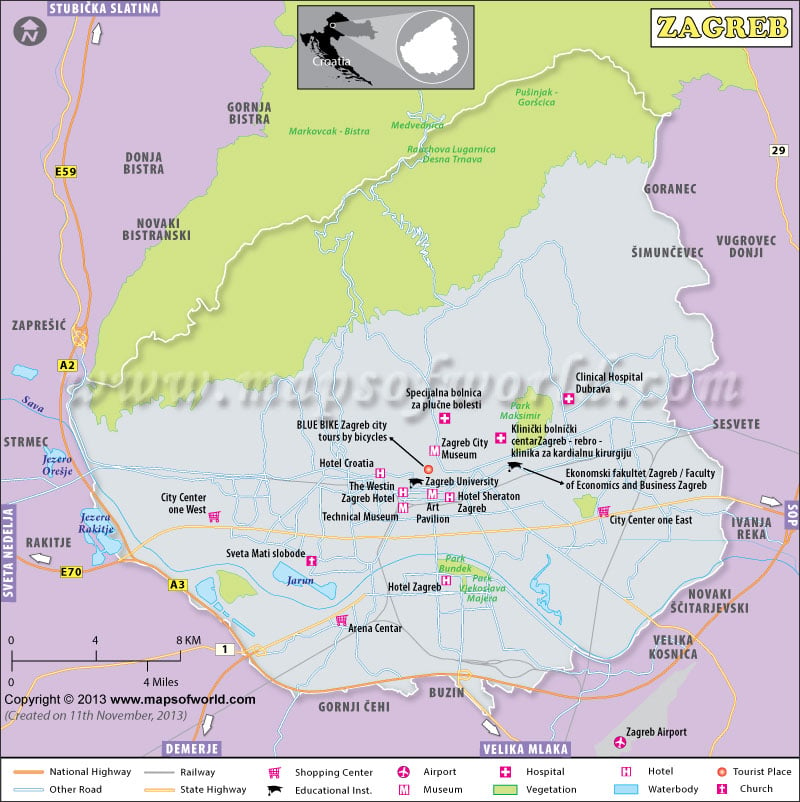Zagreb is the capital of Croatia and the nation’s largest city. It is the administrative and government center of Croatia, with most of the scientific, media, and industrial corporations basing their headquarters in this urban metropolitan.
But despite being the capital, Zagreb has a distinct identity of being a charming city with a rich history dating back to Roman times. Known for its diverse economy, historical buildings, and high quality of living, Zagreb is dubbed Europe’s little-known treasure.
Geography
Zagreb is surrounded by sprawling mountains and rivers that go through the city. The sloping hills of the Medvednica Mountains and fertile land of the Pannonian Plain are what makeup Zagreb, with the rivers of Sava, Danube, and Drava flowing through the city.
How to Reach (Modes of Transportation)
By Plane
– The Zagreb International Airport is the main airport serving the city – providing domestic and international flights to major European cities and beyond. Neighboring airports from nearby cities have smaller airports, which serve as alternative ways to get to Zagreb. The nearest airports serving low-cost carriers are Rijeka, Graz, Triesk, Klagenfurt, and Ljubljana.
By Train
– The Zagreb Central Station is where all major rails converge – offering routes to major European cities such as Vienna, Budapest, Zurich, Munich, Belgrade, and Sarajevo. For urban and suburban destinations in the city, the Croatian Railways run a network of train lines coming from the metropolitan area.
By Tram
– The most popular choice of transportation in Zagreb, tram lines offer routes to the middle and inner suburbs of the city. Running on 116.3 km with 17 lines, it is, however, non-operational on the weekends and on public holidays.
By Bus
– The Central Bus Station is the bus hub of Croatia, located southeast of the railway station, and provides both domestic and international routes.
By Taxi
– There are currently only 3 registered taxi companies running in Zagreb, with a small number of 3000 cabs. Unregistered ones are also available but may cost twice or triple compared to identified taxi companies.
When to Visit
The best time to visit Zagreb is from April to September. These months provide the most pleasant weather in Zagreb, with warm temperatures that make sightseeing and swimming popular activities. The busiest months are July and August and the city is usually packed with crowds of tourists. Some hotels and establishments also double their prices during this season.
Culture (Fairs and Festivals) and Traditions
Zagreb International Film Festival
– For 4 days every year, Zagreb’s theaters and cinemas are packed with showings of both national and international debutante films. With over 100 independent films of documentaries, short-length, and full-length features, this festival provides a fantastic platform for young and up-and-coming filmmakers to showcase their works.
Zagreb Cest is d’Best
– Every year from June 5-12, over 300 performers from four continents gather for the city’s happiest festival. Performances in music, art, dance, theater, and circus occur on the streets, with most of them interactive and involving spectators.
InMusic Festival
– The largest open-air music festival in Croatia, this festival runs for 2-3 days with local, national, and international acts from a wide range of musical genres – from heavy metal bands to independent music, and to mainstream pop acts.
Points of Interest (Places to Visit)
Dolac
– A favorite among locals and tourists, Dolac is also called the “Belly of Zagreb.” This open-air market is very hectic and extremely popular for its countless stalls of local produce and traditional foods on display.
Muzej Mimara
– Also known as the Mimara Museum, it is said to be the crown jewel attraction of the city. Its permanent collection consists of art from the prehistoric era up to the 20th century.
Museum of Broken Relationships
– A favorite among tourists, this once traveling exhibition is now located permanently in the city’s Lower Town. A museum dedicated to failed relationships, it was named Europe’s Most Innovative Museum in 2011 by the Kenneth Hudson Award. Objects left behind and defined by former lovers are donated from all over the world and are presented on display in the most minimal presentation with heartbreaking and read-between-the-lines descriptions.
Gornji Grad
– Also known as Upper Town, this square is one of 2 medieval settlements that the city was built on. Tons of historic buildings and museums can be found in this charming area of the city.
Accommodation
Because of the development of Zagreb’s International Airport, more and more tourists are able to visit the city. And along with the availability of larger airlines, hotels have become more available throughout the city. Budget hostels are becoming popular, with cheap backpacker places to stay and stylish hideaways becoming all the rage. Luxury hotels are also rampant in the city center.
